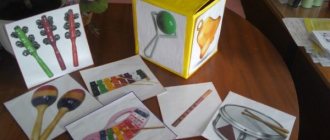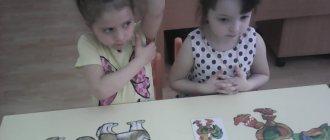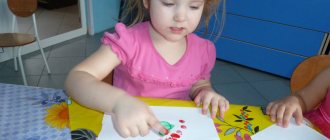Didactic games for children during music lessons
Musical games to develop a sense of rhythm in children of the preparatory department and the first year of art school
Author: Vera Olegovna Sedova, piano teacher, accompanist of the MDUDO Children's School of Children's Art School, branch in the city of Dmitrov, Moscow region Description. I offer game material for developing a sense of rhythm in children of the preparatory department and the first year of art school. This material can be used by teachers and music directors of preschool institutions, teachers of general education and music schools, parents and children themselves from five to seven years old. Goal: developing a sense of rhythm through musical creativity. Objectives: 1) teach children to listen and hear the rhythm of music, distinguishing between long and short sounds; 2) develop the child’s curiosity, ingenuity, thinking, memory, attention, imagination; 3) cultivate interest in creativity through children writing original assignments. The game is an integral part of the educational process. It helps to understand and consolidate knowledge about the material received, arouses interest, develops imagination in children and adults, turning students and teachers into co-authors of a single creative process. I offer games that I often use in the educational process at the first stage of education (preparatory and 1st grades of a children's art school), and I use them at concerts for parents so that they can see the growth of their child and can help him if he has difficulty completing his homework. I. Game “Repeat the rhythmic pattern” 1 version of the game Purpose: development of a sense of rhythm, hearing, memory, imagination, speech; give a simple idea of the length of sounds (long, short). Description. The teacher taps the rhythmic pattern of the melody with his hands or a pencil on the table, and the child repeats. Then the child comes up with a rhythm, the teacher repeats, and the student checks whether the task is completed correctly. Example.
The teacher recites the poem: Ta, ta, two cats... The child beats out the rhythm of the poem with his palms (or a finger on a key, a pencil on the table, a hand on the instrument cover, a hand on a tambourine, a stick on the key of a metallophone):
Questions for task
1. How many sounds do you hear? 2. Where are the short sounds: in the middle, at the beginning or at the end? 3. Where are the long sounds: in the middle, at the beginning or at the end? 4. How many long and short sounds did you hear? 5. Choose the correct scheme from those proposed:
2 version of the game
Purpose: development of a sense of rhythm, hearing, memory, imagination, speech; give a simple idea of the length of sounds (long, short). Description. The teacher suggests tapping the rhythm according to the table:
Questions for the task
1. Tap the rhythm on your hands and say the text.
Distinguish between long and short sounds in your voice: draw out long ones, pronounce short ones quickly. 2. Draw a diagram of notes for any verse (child or teacher’s choice). Example.
Ding, dong, ding, dong, There's an elephant walking around the zoo. The child a) recites the verse and beats out the rhythm with his hands; b) determines by ear the number of long and short sounds; c) determines their location (at the beginning, in the middle, at the end); d) writes down the outline of the verse in notes - circles.
3rd version of the game
Purpose: development of a sense of rhythm, hearing, memory, imagination, speech; give a simple idea of the length of sounds (long, short), types of sounds (noise and musical). Description. In this task, notes are written in black and white circles, as an option for first grade children. The task contains a riddle. In this task, you can repeat the questions from the second version of the game, or you can experiment with noise and musical sounds: the child knocks the rhythm in an invented way (For example, he beats long sounds with his foot, short sounds with his hands, the teacher guesses whether these are noise or musical sounds, repeats after the child task, the child checks the completion of the task, then the teacher suggests the task.)
4 version of the game Musical game “Colored Keys” Purpose: developing a sense of rhythm, hearing, memory, imagination, speech, obtaining a simple idea of the length of sounds. Opsaniye. For this game, your child will need a color keyboard,
based on which he will be able to play independently,
and also come up with your own unforgettable melodies with original poems, in the composition of which a teacher, parents, and older comrades can help. You can process the material created by your child in the Adode Photoshop program, create a personal instrumental album in paper or electronic form, and also prepare a presentation of this album with pictures and sounding melodies, record works performed by a young author on a disc, which is a nice gift to give to your mother, grandmother, friends. II. Game "Let's go!" Goal: development of a sense of rhythm, hearing, memory, imagination, speech, consolidation of knowledge about the duration of notes. Description. Game "Let's go!" - to consolidate the material when studying note durations. Children enjoy “riding” on trains. You can make carriages from colored cardboard, use different sizes in the game (2/4, 3\4, 4/4/, 3/8, 6/8, 9/8), smaller durations (sixteenth, thirty-second), give it to your child try to fill the trailers yourself with durations in accordance with the proposed size.
III. Game “Songs on Stairs” Purpose: to develop a sense of rhythm, hearing, memory, imagination, speech. Description. The game “Songs on Ladders” is another version of a rhythmic exercise with changing the pitch of sounds. Here the child learns to navigate the keyboard by changing the pitch of sounds in accordance with the picture. There are many options with a diagram. Example:
a) you can ask the child to look at the diagram in red and determine the direction of the melody (first up, then down); b) determine how many short sounds and long ones (two short, 3 long), where they go: up or down (3 sounds up, then two down); c) play a melody on the instrument from sound to (options: from D, from F, from B); d) clap the rhythm of the melody and choose words for it (I'm going for a walk); e) come up with your own ladder, draw it in an album, and compose words.
I use the games proposed in the development during the pre-notation period of teaching musical notation, which takes from a month to three, depending on the age and abilities of the child, his interest and activity. Games help to captivate the child in learning, and give the teacher room to develop his own imagination and the opportunity to use the reserves of his creative talent, implementing the slogan “Teach while playing!”
We recommend watching:
Winter musical games for children 5-9 years old Didactic materials for the preparatory class of the Children's Art School with a presentation Methodological guide to the development of musical and rhythmic abilities in children 6-8 years old Master class for parents of the older group. Musical games for children 5-7 years old
Similar articles:
Musical games for high school students
The best outdoor musical games for children
Children have a special relationship with music. They easily respond to both the melody itself and the meaning of the text, and can begin to move or even dance. That's why children really love musical games with movements - during such games you can have a lot of fun and never get bored!
In turn, musical games are very useful for children of preschool and primary school age. They develop a sense of rhythm, artistry and coordination of movements, help develop creative abilities, teach how to get along with people and establish contact with them. This is a wonderful way to spend time outside and indoors in an interesting and useful way, but it should be noted that most outdoor games require free space.
We bring you a selection of the five best children's music games with movements that are suitable for children from 3 to 10 years old.
Game "Chairs"
This ancient children's game is probably known to everyone. In the middle of the room, chairs are placed in a circle, the number of which is one less than the number of children. The adult presenter plays cheerful music, to which everyone dances around the chairs. As soon as the music stops, the players must take each of their chairs. The one who does not get a chair is eliminated, and he takes one chair with him. Thus, there is always one less chair than players.
Game "Wolf Under the Mountain"
Among the children, the one who will play the wolf is chosen, the rest are considered geese. The wolf is hiding somewhere in a secluded place - “under the mountain.” Children pretend to be geese and walk to calm music. As soon as the music changes to louder and faster, a wolf jumps out and tries to catch the geese for himself. The last one caught becomes a wolf himself.
Game "Magic Hat"
Before starting this active musical game for children, you need to prepare a big hat. The more unusual it looks, the more “magical” it will seem.
Children and the leading adult stand in a circle, with the leader holding a hat. The music turns on, and the hat begins to be passed around in a circle, from hand to hand. Suddenly the music ends. The one who has a hat in his hands must put it on his head. The hat “works magic” and turns the player into some character. You need to go to the center of the circle and portray someone: a fairy-tale character, an animal or an object, while you cannot use words, only sounds, movements and facial expressions. The rest of the game participants must guess who the owner of the magic hat is portraying. The one who guessed correctly gets a hat, everyone stands in a circle again and the game continues.
Musical game "Mirror"
A leader is selected who faces everyone else. He will be the main leader, and the rest will be his reflections in the mirror. To the accompaniment of cheerful and mischievous music, the presenter begins to show various movements, which the “reflections” must repeat exactly. It can be jumping, squats, swinging arms or legs, dance steps - anything. At the end of the melody (usually 2-2.5 minutes), a new presenter is selected.
Game "Unusual dances"
5 short musical compositions are selected. To the first of them you need to dance only with your hands, to the second - only with your feet, then only with your head, then - only with your face, and finally, all together.
All these active musical games for children will be great entertainment at any children's party, event, or just while walking with several children at the same time. If you want to use them outdoors, instead of playing recorded music, you can simply play short songs or even hum melodies without any words.
Interactive game for children of senior preschool age “Musical Pages”
This resource is intended for children of senior preschool age, but in practice we used it with children of middle preschool age and with children in the group with mental retardation.
This manual includes games and riddles aimed at consolidating knowledge on the topic “Musical Instruments” in a playful way. “Find the extra” Goal: to consolidate the ability to classify and generalize knowledge. children are offered 4 tasks, the child chooses:
Task No. 1 (trombone, flute, pipe, horn, violin) An image of musical instruments appears on the screen, the child must identify the extra instrument, when choosing the wrong answer, the child hears the phrase “Think”, and the image does not disappear, only sways. When choosing the correct answer, the child hears the praise “Well done!” and the extra tool disappears from the screen. To continue, you need to press the arrow to the right; if the child wants to return to the main page, you need to select “House”; if there is a rounded arrow on the task selection page.
“Musical chest” Purpose: to consolidate children’s knowledge of musical instruments, groups of musical instruments, to stimulate auditory attention.
Children are invited to listen to a fragment of the sound of a chosen musical instrument. It is especially interesting for a preschooler to hear the sounds of the chosen musical instrument.
Puzzles. Goal: acquaintance with musical instruments through folk art. The riddles are voiced, the child hears, guesses the riddle and sees a picture - the answer, hears the word and is sure to receive praise.
The games include animation effects, which makes it possible to improve feedback with children and provide more comfortable conditions for conducting classes and an individual approach to learning, allowing you to show the world of music much richer and brighter, and connect visual and auditory ideas.
It should also be taken into account that the duration of classes using a computer for preschool children is in accordance with the requirements of SanPiN.
cannot exceed 7-10 minutes. For the full text of the material Interactive game for children of senior preschool age “Musical Pages”, see the downloadable file
. The page contains a fragment.
| Author: Khvoina N. M., Tveritina G. G. → Publisher 08/18/2017 2 8429 1602 | Comment |
Thank you for your mark. If you want your name to be known to the author, log in to the site as a user and click Thank you again. Your name will appear on this page.
Login | Registration
Have an opinion? Leave a comment










